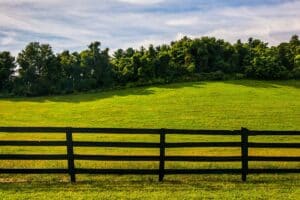Those of us who live and work in what the New Yorker might consider the muddle of the American nowhere may have once believed that life at the fat end of the Nation’s political telescope made things that looked far away be even farther. Some of us even thought we had disconnected ourselves from the turmoil of modern society.
No more.
While nobody in my county of 2,500 has a Bloomberg terminal, each of us now understands that the number of dollars we have in our wallets depends on who’s doing what around the world and for how much. National and global forces determine the price of our cattle, poultry and timber; whether tourists visit; and how much money state government gives us for education, roads and law enforcement.
Some of us support an economic stimulus package, and some don’t. But most might agree on a few ideas that would help get things moving out here almost immediately and do some public good to boot.
Fence livestock out of moving water. Livestock define bathrooms differently than most people. For this reason, they pollute rivers and streams differently than we do.
Both pasture run-off and direct deposits add nutrients that cause problems from the Chesapeake Bay to the Gulf of Mexico. Farm pollution of this type is not regulated.
The way to address this problem is to fence livestock out of running water.
This is a monumentally unpopular idea with livestock farmers, including me. “Making fence” is hard, miserable, back-spraining, expensive work. The old fence has to be dismantled and carted off. Then new posts — wood or steel — have to be driven into the ground and wire fastened from one to the next along the entire line. Tons of material have to be moved around. My rule of thumb – or what’s left of it after old barbed wire has ripped it apart — is each day of fence work is to be followed by two days of aspirin and motionless potato couching.
Since the Nation would benefit from protective fencing built to federal standards by local builders, its cost could be part of the stimulus package.
To the extent that we improve the quality of our rivers and coasts with “clean-water fencing,” we have upgraded our farm infrastructure as well as our green infrastructure.
Fence-building is done in the spring, that is, two months from now.
Plant trees. Trees control erosion and pollution, store carbon, make oxygen, provide sustainable building materials and paper products, help wildlife and are emerging as a feedstock for “treethanol,” a substitute for gasoline. Trees push money through rural economies.
Trees can be planted one by one in existing woodlands or in dedicated plantations for wood products or energy.
Technologies for converting wood into ethanol on a commercial scale are five to ten years off. Fast-growing species — like the hybrid poplar developed at the Oak Ridge National Lab — can be planted now and be ready then. The worst outcome of planting trees is good–additional forest cover, more carbon capture, more sustainable products, more money in the countryside.
Wood-based ethanol reduces greenhouse-gas emissions by 80 percent or more compared with gasoline while corn-based ethanol reduces them by only 10 to 20 percent. Further, the energy balance (energy produced in terms of energy added) for cellulosic ethanol is much higher than corn, which some even argue is a net-energy loser.
Marginal farmland and old strip mines can be used for plantations. Much of this type of land is found in poorer parts of rural America where unemployment and underemployment is chronically high.
Stimulus funding can either pay for, or cost-share, the site preparation, seedlings, planting, fencing. maintenance and tending. Landowners could be required to repay some, or all, of the get-started costs when they sell their “stimulus timber.”
Spring is a good time to plant trees, that is, two months from now.
Run the schools through much of the summer. American students do not match the scores of kids from several dozen other countries. In 2006, the U.S. was not in the top 20 nations in math, science or reading, according to results of the world-wide test given to 15 year olds every three years by the Programme for International Student Assessment.
One reason for our poor performance is that most of the higher-achieving students are in school longer than the average American school year of 180 days. The South Korean year is about 40 days longer; Japan, about 60. Might more schooling leave fewer American children behind?
Washington could include “stimulus summer schooling” for districts willing to extend the school year for six weeks to find out.
School is out in May or June, that is, about four months from now.
Fund safety improvements on rural roads. You may want country roads to take you home, but getting around out here safely is another song.
States fund road maintenance, but improving the safety of two-lane roads seems to be a low priority. On my four-mile-long road, we have five blind turns, two of which are really bad and a third routinely causes near misses as well as the occasional hit. It’s been like this since the early 1950s.
Needed improvements are small widening and straightening projects, regrading curves, painting pavement edges, guardrails and bridge work. Local excavators could do some of these jobs.
Every state has a county-by-county road-improvement plan with prioritized projects. States could administer this program and allocate funding. Everything’s in place.
“Safety stimulus projects” could start a little later in the spring, about three months from now.
Each of these ideas would pump money into different sectors of a rural county’s economy. And more than that, tangible public benefits would be gotten for the dollars given.
Here we are: Stimulate us!
This content may not be used or reproduced in any manner whatsoever, in part or in whole, without written permission of LANDTHINK. Use of this content without permission is a violation of federal copyright law. The articles, posts, comments, opinions and information provided by LANDTHINK are for informational and research purposes only and DOES NOT substitute or coincide with the advice of an attorney, accountant, real estate broker or any other licensed real estate professional. LANDTHINK strongly advises visitors and readers to seek their own professional guidance and advice related to buying, investing in or selling real estate.









Add Comment